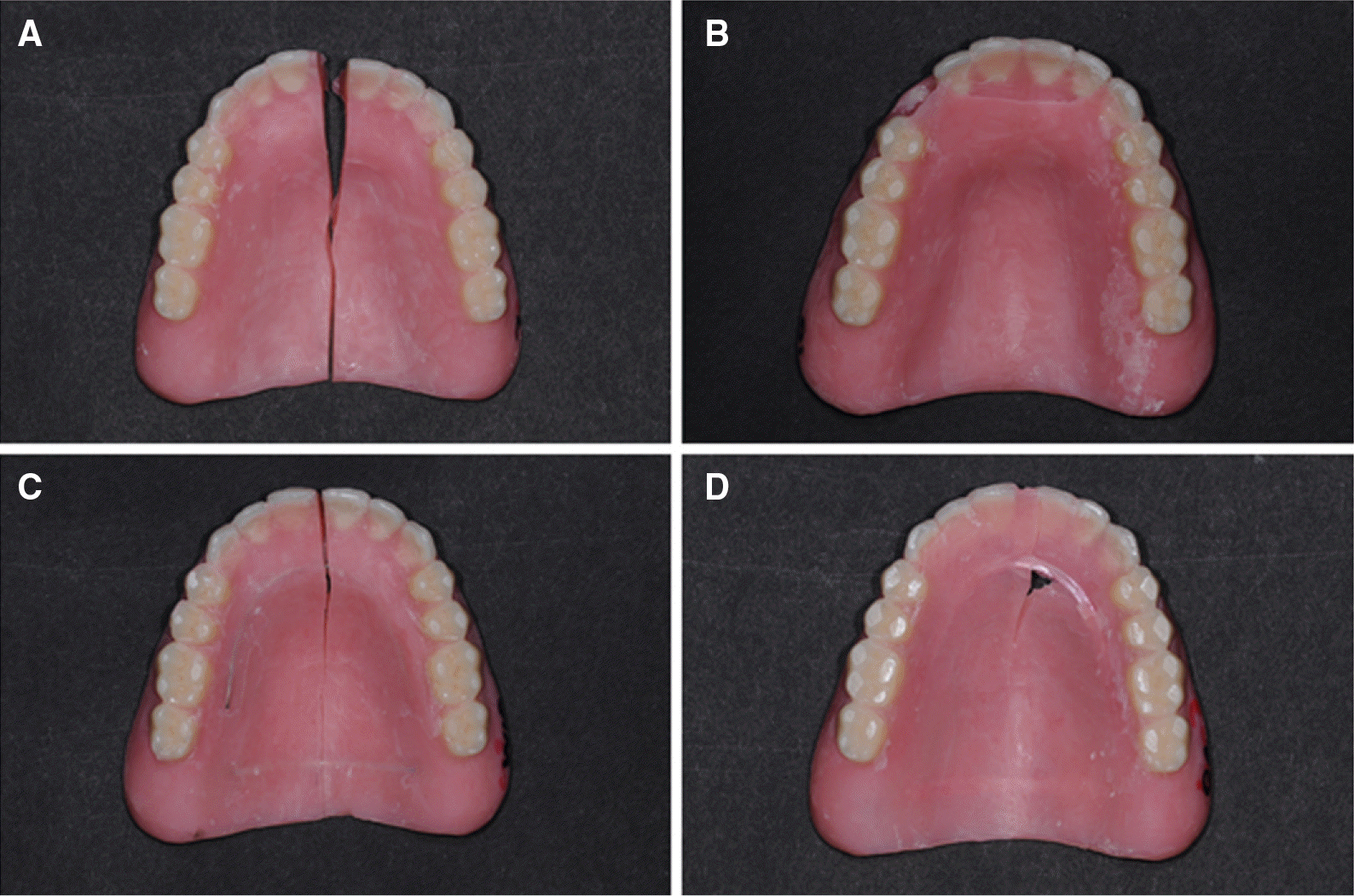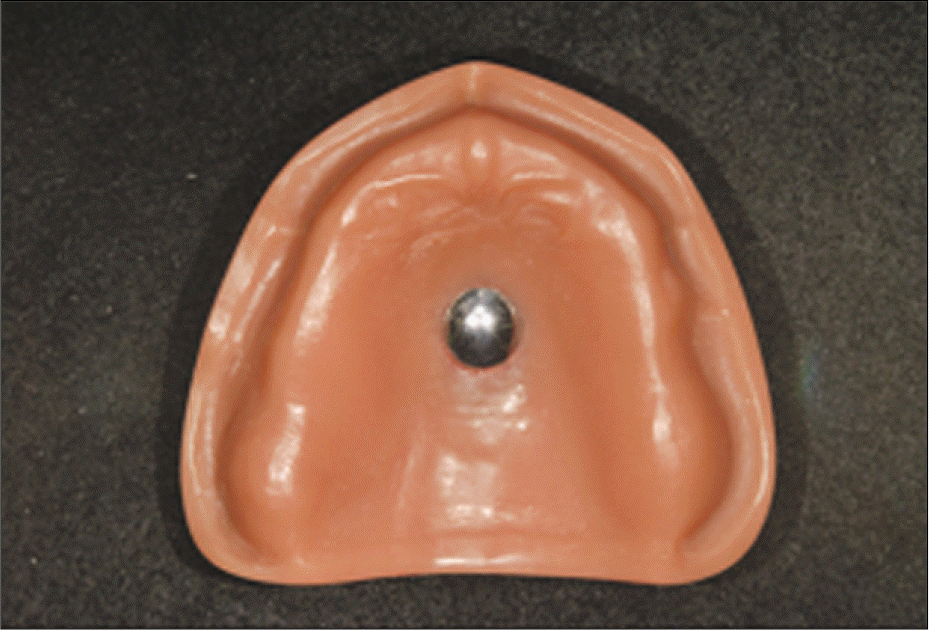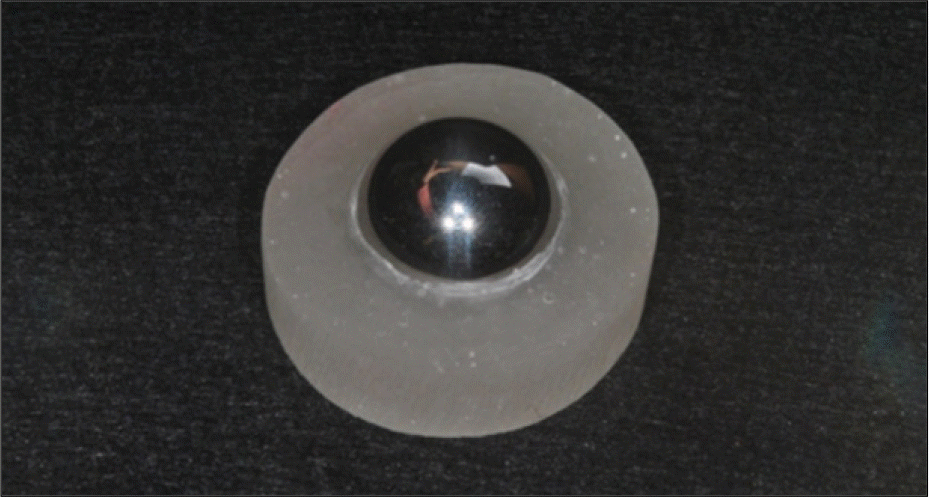Abstract
Purpose
This study compared fracture strength and fracture modes between metal wire reinforcement and glass fiber reinforcement in repaired maxillary complete denture.
Materials and methods
In this study, fracture was reproduced on center of maxillary complete dentures and the denture was repaired with auto-polymerizing resin. The experimental groups (n = 10) were subjected to the following condition: without reinforcing material (control group), reinforcing with metal wire (W group), reinforcing with glass fiber pre-impregnated with light-curing resin (SES MESH, INNO Dental Co., Yeoncheon, Korea, G group). The fracture strength and fracture modes of a maxillary complete denture were tested using Instron test machine (Instron Co., Canton, MA, USA) at a 5.0 mm/min crosshead speed. The flexure load was applied to center of denture with a 20 mm diameter ball attachment. When fracture occurred, the fracture mode was classified based on fracture lines. The Kruskal-wallis test and the Mann-whitney U test were performed to identify statistical differences at α =.05.
Go to : 
REFERENCES
1.Vallittu PK., Lassila VP., Lappalainen R. Evaluation of damage to removable dentures in two cities in Finland. Acta Odontol Scand. 1993. 51:363–9.

2.Hargreaves AS. The prevalence of fractured dentures. A survey. Br Dent J. 1969. 126:451–5.
4.Smith DC. The acrylic denture. Mechanical evaluation, midline fractures. Br Dent J. 1961. 110:257–67.
5.Yoshida K., Takahashi Y., Shimizu H. Effect of embedded metal reinforcements and their location on the fracture resistance of acrylic resin complete dentures. J Prosthodont. 2011. 20:366–71.

6.Takahashi T., Gonda T., Maeda Y. Influence of reinforcing materials on strain of maxillary complete denture. Acta Odontol Scand. 2013. 71:307–11.

7.Vallittu PK., Lassila VP. Reinforcement of acrylic resin denture base material with metal or fibre strengtheners. J Oral Rehabil. 1992. 19:225–30.

8.Vallittu PK., Lassila VP. Effect of metal strengthener's surface roughness on fracture resistance of acrylic denture base material. J Oral Rehabil. 1992. 19:385–91.

9.Jacobson TE., Chang JC., Keri PP., Watanabe LG. Bond strength of 4-META acrylic resin denture base to cobalt chromium alloy. J Prosthet Dent. 1988. 60:570–6.

10.Vallittu PK. Effect of some properties of metal strengtheners on the fracture resistance of acrylic denture base material construction. J Oral Rehabil. 1993. 20:241–8.
11.Ruffino AR. Effect of steel strengtheners on fracture resistance of the acrylic resin complete denture base. J Prosthet Dent. 1985. 54:75–8.

12.Vallittu PK. Dimensional accuracy and stability of polymethyl methacrylate reinforced with metal wire or with continuous glass fiber. J Prosthet Dent. 1996. 75:617–21.

13.Tsue F., Takahashi Y., Shimizu H. Reinforcing effect of glass-fiber-reinforced composite on flexural strength at the proportional limit of denture base resin. Acta Odontol Scand. 2007. 65:141–8.

14.Narva KK., Lassila LV., Vallittu PK. The static strength and modulus of fiber reinforced denture base polymer. Dent Mater. 2005. 21:421–8.

15.Narva KK., Lassila LVJ., Vallittu PK. Flexural fatigue of denture base polymer with fiber-reinforced composite reinforcement. Composites Part A. 2005. 36:1275–81.

16.Stipho HD. Effect of glass fiber reinforcement on some mechanical properties of autopolymerizing polymethyl methacrylate. J Prosthet Dent. 1998. 79:580–4.

17.Jeong CM., Jeon YC. Reinforcement of acrylic resin metal wire. J Korean Acad Prosthodont. 1996. 34:823–32.
18.Takahashi Y., Yoshida K., Shimizu H. Effect of location of glass fiber-reinforced composite reinforcement on the flexural properties of a maxillary complete denture in vitro. Acta Odontol Scand. 2011. 69:215–21.
19.Ward JE., Moon PC., Levine RA., Behrendt CL. Effect of repair surface design, repair material, and processing method on the transverse strength of repaired acrylic denture resin. J Prosthet Dent. 1992. 67:815–20.

20.Stipho HD., Stipho AS. Effectiveness and durability of repaired acrylic resin joints. J Prosthet Dent. 1987. 58:249–53.

21.Stipho HD. Repair of acrylic resin denture base reinforced with glass fiber. J Prosthet Dent. 1998. 80:546–50.

22.Lin CT., Lee SY., Tsai TY., Dong DR., Shih YH. Degradation of repaired denture base materials in simulated oral fluid. J Oral Rehabil. 2000. 27:190–8.

23.Thean HP., Chew CL., Goh KI., Norman RD. An evaluation of bond strengths of denture repair resins by a torsional method. Aust Dent J. 1998. 43:5–8.

24.Vallittu PK., Ruyter IE. Swelling of poly(methyl methacrylate) resin at the repair joint. Int J Prosthodont. 1997. 10:254–8.
25.Dar-Odeh NS., Harrison A., Abu-Hammad O. An evaluation of self-cured and visible light-cured denture base materials when used as a denture base repair material. J Oral Rehabil. 1997. 24:755–60.

26.Berge M. Bending strength of intact and repaired denture base resins. Acta Odontol Scand. 1983. 41:187–91.

27.Rached RN., Powers JM., Del Bel Cury AA. Repair strength of autopolymerizing, microwave, and conventional heat-polymerized acrylic resins. J Prosthet Dent. 2004. 92:79–82.

28.Minami H., Suzuki S., Kurashige H., Minesaki Y., Tanaka T. Flexural strengths of denture base resin repaired with autopolymerizing resin and reinforcements after thermocycle stressing. J Prosthodont. 2005. 14:12–8.

29.Vallittu PK. Glass fiber reinforcement in repaired acrylic resin re- movable dentures: preliminary results of a clinical study. Quintessence Int. 1997. 28:39–44.
30.Kostoulas I., Kavoura VT., Frangou MJ., Polyzois GL. Fracture force, deflection, and toughness of acrylic denture repairs involving glass fiber reinforcement. J Prosthodont. 2008. 17:257–61.

31.Narva KK., Vallittu PK., Helenius H., Yli-Urpo A. Clinical survey of acrylic resin removable denture repairs with glass-fiber reinforcement. Int J Prosthodont. 2001. 14:219–24.
32.Yazdanie N., Mahood M. Carbon fiber acrylic resin composite: an investigation of transverse strength. J Prosthet Dent. 1985. 54:543–7.

33.DeBoer J., Vermilyea SG., Brady RE. The effect of carbon fiber orientation on the fatigue resistance and bending properties of two denture resins. J Prosthet Dent. 1984. 51:119–21.

34.Mullarky RH. Aramid fiber reinforcement of acrylic appliances. J Clin Orthod. 1985. 19:655–8.
35.Lee KP., Kelly DP., Kennedy GL Jr. Pulmonary response to inhaled Kevlar aramid synthetic fibers in rats. Toxicol Appl Pharmacol. 1983. 71:242–53.

36.Dunnigan J., Nadeau D., Paradis D. Cytotoxic effects of aramid fibres on rat pulmonary macrophages: comparison with chrysotile asbestos. Toxicol Lett. 1984. 20:277–82.

37.Vallittu PK., Lassila VP., Lappalainen R. Transverse strength and fatigue of denture acrylic-glass fiber composite. Dent Mater. 1994. 10:116–21.

38.Jang J., Han S. Mechanical Properties of Glass-fiber Mat/PMMA Functionally Gradient Composites, Composite: Part A. 1999. 30:1045–53.
39.Vertex-dental. http://www.vertex-dental.com/en/products/18-en/26/142-vertex-rapid-simplified/. 2013/10/23.
40.Vertex-dental. http://www.vertex-dental.com/en/products/19-en/26/155-vertex-self-curing/. 2013/10/23.
Go to : 
 | Fig. 2.Location of reinforcement materials in midline fracture of maxillary complete denture. A: without reinforcement (control group), B: with metal wire reinforcement (group W), C: with glass fiber reinforcement (group G). |
 | Fig. 5.Fracture mode of denture. A: anteroposterior fracture in control group, B: anterior region fracture in control group, C: anteroposterior fracture in group W, D: fracture along the lines with reinforcement in group G. |
Table 1.
Mean and Standard deviation of fracture strength (kgf) and Kruskal-Wallis test
| Group | N | Fracture strength (kgf) | Kruskal-Wallis | |
|---|---|---|---|---|
| (mean ± SD) | x2 (H) | P value | ||
| Control | 10 | 117.14 ± 20.018 | ||
| G | 10 | 116.50 ± 18.921 | 9.492 | .009∗ |
| W | 10 | 149.75 ± 26.292 | ||




 PDF
PDF ePub
ePub Citation
Citation Print
Print





 XML Download
XML Download